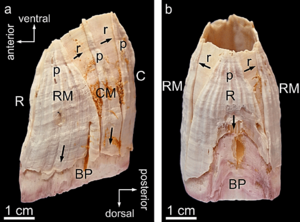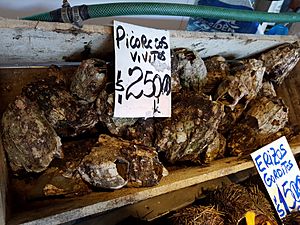Giant barnacle facts for kids
Quick facts for kids Giant barnacle |
|
|---|---|
 |
|
| Exoskeleton (shell) of the giant barnacle | |
| Scientific classification | |
| Genus: |
Austromegabalanus
|
| Species: |
psittacus
|
The giant barnacle, also known as Austromegabalanus psittacus or picoroco in Spanish, is a very large type of barnacle. It lives along the coasts of southern Peru, all of Chile, and southern Argentina. You can find it on rocky shores in the littoral and intertidal zones, which are areas near the sea.
This barnacle can grow up to 30 centimetres (12 in) tall. It has a strong, hard shell made of a mineral called calcite. The picoroco barnacle is a popular food in Chilean cuisine and is often used in a traditional dish called curanto.
Contents
What is a Giant Barnacle?
Austromegabalanus psittacus is a large sessile barnacle. This means it stays fixed in one place and does not move around. These barnacles usually live in groups on hard surfaces like rocks.
They have a tall, cone-shaped outer shell, called a carapace. This shell is made of twelve big plates of calcite microcrystals, which are tiny mineral pieces. These plates are strongly glued together. The bottom part of the barnacle is firmly attached to a hard surface.
At the top of the shell, there is an opening with a hinged lid, called an operculum. Through this opening, the barnacle can stick out its feeding limbs, which are called "cirri." The giant barnacle is usually a dull white color with purple and brown marks.
Life Cycle and How They Grow
Austromegabalanus psittacus is a hermaphrodite. This means each barnacle has both male and female reproductive parts. To reproduce, one barnacle extends a thin tube to fertilize a neighboring barnacle.
After fertilization, the eggs stay inside the barnacle's shell. They are kept safe there for about three to four weeks. Then, the eggs hatch into tiny, free-swimming larvae called nauplius larvae. These larvae float around as part of the plankton in the ocean.
The larvae go through six different stages over about 45 days. The last stage is called a cyprid larva. These larvae are about 1 mm (0.04 in) long. When they are ready, they settle down on the seabed, usually close to other barnacles.
Sometimes, many larvae settle very close together. As these young barnacles grow, they can form large bumps or mounds, called hummocks. In these hummocks, the barnacles in the middle can become about twice as tall as the ones on the outside. This is because their base changes into a more porous, cylindrical shape.
These hummocks can be very dense, with over 1000 barnacles in just one square meter. Being able to form these hummocks helps the giant barnacle compete for space with other types of barnacles. The giant barnacle is an omnivorous filter feeder, meaning it eats both plants and animals by filtering tiny bits of food from the water.
Where Giant Barnacles Live
Austromegabalanus psittacus is a coastal species. You can find it in southern Peru, all along the coast of Chile (including the Juan Fernández Islands offshore), and in southern Argentina. It lives in the intertidal and littoral zones, which are the areas of the shore that are covered and uncovered by tides.
These barnacles have been found at depths from 0–35 m (0–115 ft), but they are most commonly seen between 2–20 m (7–66 ft) deep. They are most common in the Los Lagos area of Chile. People harvest them there for food, especially in towns like Calbuco, Carelmapu, and Puerto Montt.
How Humans and Other Animals Use Them

The giant barnacle is an important part of Chilean food. Its meat is highly valued and is a key ingredient in the traditional Chilean dish called curanto. This dish is usually cooked in a large pit that has been heated with very hot stones. Nowadays, people often cook curanto in a large pot on a stove.
Because so many giant barnacles have been caught for food, their numbers have gone down. There are now plans to farm them along the coast of Chile. There is also a chance that they might be exported to Japan for food.
Besides humans, some other ocean animals also eat the giant barnacle. The sea star Heliaster helianthus sometimes eats them. Also, a type of fish called the clingfish Sicyases sanguineus can eat smaller barnacles, but larger Austromegabalanus psittacus are usually too big for them to prey on.



